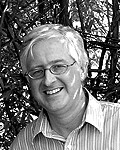
William FitzGerald, an assistant professor of English at Rutgers–Camden, says that while it has been popularly used as a tool for moral development, the prayer originally had a broader intent: to inspire social and political action in addition to personal spiritual growth.
“The Serenity Prayer is arguably the most popular prayer of the 20th century,” says FitzGerald, who teaches classes in rhetoric and writing studies and researches the rhetoric of religion and prayer.
“People respond to the prayer because it’s a rhetoric of hope,” he says. “Everybody knows it as the text of personal transformation, but there are in fact two distinct versions of the text that are very different.”
The most commonly cited version of the prayer reads: “God, grant me the serenity to accept the things I cannot change, courage to change the things I can, and wisdom to know the difference.”
But the version credited to its widely recognized author, Reinhold Niebuhr, differs in that it is written in passive voice and in the third person: “God, give us grace to accept with serenity the things that cannot be changed, the courage to change things that should be changed, and the wisdom to distinguish one from the other.”
In one version, the speaker is asking for serenity. In the other, which FitzGerald says Niehbur prefers, the speaker is asking for grace to accept with serenity.
FitzGerald says Niebuhr’s version was translated into the more popular, less theological idiom recognized today.
“I argue that it’s kind of a misnomer in that it’s called the Serenity Prayer,” he says. “In the more familiar version, serenity is the goal of the prayer; it’s about finding serenity in a world of challenge and discomfort. But if you read Niebuhr’s version, serenity is a byproduct rather than a goal.”
Early in the prayer's reception, it underwent a series of revisions that changed it from its original intent into its current context, and turned it from a meditation to an aphorism, FitzGerald says.
“It became almost too eloquent and memorable for its own good,” he contends. “Overall, the revised prayer is reduced to 25 pithy words, perfect for reproduction as religious poetry on many devotional objects. These changes tune the prayer to therapeutic use and enable it to flourish in the highly individualized spiritual culture of late twentieth century America.”
Though the origins of the prayer have also been attributed to historical figures long before the 20th century, Niebuhr, the theologian credited as the author, often recited the prayer to conclude sermons.
By 1944, he permitted its inclusion in the Federal Council of Churches Book of Prayers and Services for the Armed Forces. Shortly thereafter, it was adopted and promoted by Alcoholics Anonymous.
“Since then, it’s been made a much more personal prayer,” FitzGerald explains.
But when looking closely at how Niebuhr’s version is worded, FitzGerald contends that the original intent wasn’t to seek personal guidance.
“The key word in his passage is ‘us,’” FitzGerald says. “Niebuhr views it as a collective prayer.”
The Rutgers–Camden professor says Niebuhr’s version focuses on courage rather than serenity. The earliest documented version of the prayer, dating back to 1937, actually begins by asking for courage.
“It’s not the serenity prayer any more than it is the courage prayer or the wisdom prayer,” FitzGerald says.
In the modern version, “attaining serenity becomes the purpose of the prayer,” he says.
“In a very secularized age, the prayer stands as a kind of hope that there is something in prayer itself that has a transformative power; that cultivates insight and virtue,” he says. “It’s very generic, as opposed to the Lord’s Prayer or the Hail Mary. You might argue that it’s not so much as a prayer as it is an affirmation, that it’s more of an address to one’s self as it is to God. It’s an effort to understand the situation we are in at the moment.”
A Philadelphia resident, FitzGerald received his undergraduate degree from Haverford College and his master’s degree and doctorate from the University of Maryland.
-30-
Media Contact: Ed Moorhouse
(856) 313-8020
E-mail: ejmoor@camden.rutgers.edu